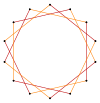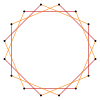User:Tomruen/Quasiregular and isogonal polygons
Quasiregular polygon[edit]
Quasiregular polygons alternation two types of edges are constructed as truncations of the regular star polygons. These polygons are isogonal (vertex-transitive).
Some definitions of quasiregular include the isogonal duals, i.e. isotoxal (edge-transitive) polygons with one type of edge, but alternate two types of vertices. Both isogonal and isotoxal variations have half the symmetry of the regular polygon, but the lines symmetry are on the edges in the first, and the vertices on the second.
A truncated regular polygon, t{p}, is geometrically the same as a regular {2p}.
 t{3} ={6} |
 t{4} ={8} |
 t{5} ={10} |
 t{6} ={12} |
A truncated regular star polygon, t{p/q}, is geometrically the same as a regular {2p/q} with odd q. Some others can be construcated as quasitruncated regular star polygon by reverse the orientation, expressed as {p/(p-q)}. The quasitruncation t'{p/q} is the same as the truncation {p/(p-q)}, and again is same as the regular {2p/(p-q)}, except with two types of edges, again reqiring (p-q) odd.[1][2]
 t'{4}=t{4/3} ={8/3} |
 t'{5/2}=t{5/3} ={10/3} |
 t{7/3} ={14/3} |
 t'{7/2}=t{7/5} ={14/5} |
 t{8/3} ={16/3} |
 t'{8/3}=t{8/5} ={16/5} |
Isogonal star polygons[edit]
The quasiregular star polygon t{p/q} has a continuous isogonal transformation to t{p/(p-q)}. Some of the positions have overlapping vertices which can be seen as degenerate edges, or double-wound polygons.[3]
 {3} |

|
 t{3}={6} |

|
 r{3}={3} |

|

|

|

|
 t{3/2}={6/2} |

|

|

|

|

|

|
 ... ...
|

|

|

|

|

|
 {5} |

|
 t{5}={6} |

|
 r{5}={5} |

|

|

|
 t{5/2}={10/2} |

|

|

|

|

|
 ... ...
|

|

|

|

|

|
 {6} |

|
 t{6}={12} |

|
 r{6}={6} |

|

|

|
 t{6/2}={12/2} |

|

|

|

|

|
 ... ...
|

|

|

|

|

|
References[edit]
- ^ *Coxeter, Harold Scott MacDonald; Longuet-Higgins, M. S.; Miller, J. C. P. (1954). "Uniform polyhedra". Philosophical Transactions of the Royal Society of London. Series A. Mathematical and Physical Sciences. 246 (916). The Royal Society: 411. doi:10.1098/rsta.1954.0003. ISSN 0080-4614. JSTOR 91532. MR 0062446.
- ^ Coxeter, The Densities of the Regular polytopes I, p.43 If d is odd, the truncation of the polygon {p/q} is naturally {2n/d}. But if not, it consistents of two coincident {n/(d/2)}'s; two, because each side arises from an original side and once from an original vertex. Thus the density of a polygon is unaltered by truncation.
- ^ The Lighter Side of Mathematics: Proceedings of the Eugène Strens Memorial Conference on Recreational Mathematics and its History, (1994), Metamorphoses of polygons, Branko Grünbaum, a {p/q} regular polygon can be transformed into {p/(p/2-q} by a continous sequence of intermediate isogonal polygons.




